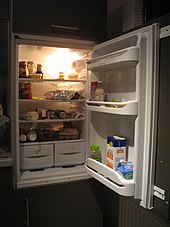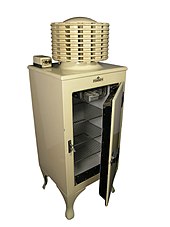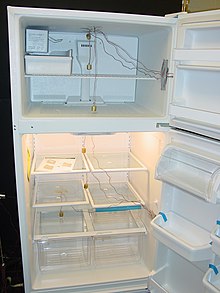Refrigerator

Arefrigeratoris a machine used for keeping things cold. It is sometimes called afridgeor anicebox.It is normally maintained at 4-5 degree Celsius for household use. People putfoodanddrinksin it, to keep those itemscoldor good (unspoiled) for a longer time. A refrigerator has aheat pumpwhich takes heat away from theairinside the fridge. The heat is moved to the air outside. The heat pump is usually driven by anelectric motor.

There are also ice boxes available that do not use electricity because they are filled with ice to provide the colder temperature. The ice can keep things cold until the ice melts. Ice boxes can be taken oncampingtrips. Sometimes they are called coolers. Refrigerator-sized iceboxes were used before electricity was available.
Most modern refrigerators are available in a variety ofcolours,although most are white. Smaller versions of the popular refrigerator are also used. They are mainly used inhotelsandcollegedorm rooms.
Freezer
[change|change source]
Afreezeris a special type of refrigerator that stores food at freezing temperatures. Inside a freezer, it is normally −18 °C (0 °F). Freezers can be found in household refrigerators, as well as in industry and commerce. When stored in a freezer,frozen foodcan be stored safely for a longer time than storing at room temperatures.[1]
Domestic freezers can be a separate compartment in a refrigerator, or can be a separate appliance. Household refrigerators usually have a separate compartment where the heat pump is used to pump even colder temperatures to the contents. Most household freezers maintain temperatures from −23 to −18 °C (−9 to 0 °F). Some freezer-only units can achieve −34 °C (−29 °F) and lower. Most household refrigerators generally do not achieve a temperature lower than −23 °C (−9 °F), because it is difficult to control the temperature for two different compartments. This is because both compartments shares the same coolant loop.
Domestic freezers normally stand upright, resembling refrigerators. Sometimes a domestic freezer is laid on its back to look like achest.Many modern upright freezers come with anice dispenserbuilt into their door. Many commercial freezers stand upright and have glass doors so shoppers can see the contents.
Home freezers with larger compartments or as separate units were introduced in the US in 1940, making frozen foods common. In 1955, deep freezers that allowed people to freeze their own fresh food went on sale.[2][3][4]A walk-in freezer lets people walk inside. Safety rules require an emergency release to prevent anyone from getting trapped, ashypothermiacan occur if someone is inside for too long. Employers should check these regularly.[5]
References
[change|change source]- ↑"Freezing and food safety".USDA.Archivedfrom the original on 18 September 2013.Retrieved6 August2013.
- ↑Barnes-Svarney, Patricia; Svarney, Thomas E. (23 February 2015).The Handy Nutrition Answer Book.Visible Ink Press.ISBN9781578595532.Archivedfrom the original on 25 April 2023.Retrieved14 March2023.
- ↑"75 Degree AC".Retrieved2024-08-15.
- ↑"Power To The People – Chicago Tribune".Chicago Tribune.25 February 1990.Archivedfrom the original on 16 January 2023.Retrieved16 January2023.
- ↑"What are The Health and Safety Standards for Walk-in Refrigeration?".March 28, 2024.RetrievedMay 24,2024.
Other websites
[change|change source] Media related toDomestic refrigeratorsat Wikimedia Commons
Media related toDomestic refrigeratorsat Wikimedia Commons
